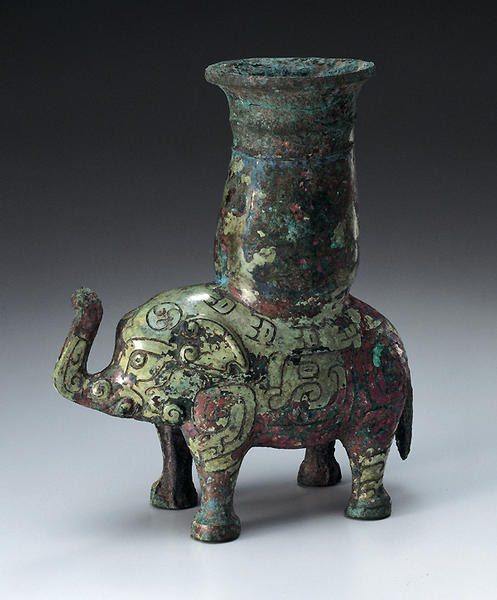象形罇
- 中国
- 西周時代
- 前1050年-前950年頃
- 青銅
- H-17.8 W-7.2
この愛らしい形をした容器は二つの相容れない伝統を結合している。上部の円筒形の器は安陽末期から西周初期にかけてのzhi酒器であるがそれを象の形象が支えている。象の形をした器はいくつかある中でもこれは大変稀な例である。これは華北で周王朝初期に制作されたものと考えられ、北西の小国であった周の文化が中原の文化に触発され、その独特の美的感性を表現した作品であると言えるであろう。
この青銅器は周の初期につくられたものと考えられ、殷の伝統意匠の要素を受け継いで、その体躯に龍文を施した静謐な象の形象を作り出しているが、象が器台とされている点で特有の雰囲気を持っている。その背中の器の形態は殷の酒器、し(角さかづき)に由来するものであり、通常単一の器として使用されるものである。古くから儀式の器に使用された象尊(そん:酒を盛る器)は背中に口が空けられ胴部が器となっているのであって、背中に特別な器を載せることはなかった。これは言わば、象しとでも呼ぶべきものであろう。
Catalogue Entry
This charming vessel is truly unique.1 In conception, it combines unblended references to two artistic traditions. The attenuated upper container with raised ridges reproduces the rather bland form of late Anyang and early Western Zhou zhi wine cups, while the base is a handsome pachyderm.2 Although several containers in the shape of elephants are known, it is extremely rare to see vessels supported by animals of any kind.2 Among metropolitan Anyang Shang bronzes, there is an unusual group of ding cauldrons with flat legs resembling birds or dragons.2 More closely related are two zun believed to have been made in south China that are designed as free-standing, back-to-back animals supporting tall, rounded containers.5
In many ways, the decoration on this vessel resembles that on the southern buffalo zun discussed in the previous entry (cat. no. 80). This zun, however, was not created in the south, but in the north during the opening century of the Zhou dynasty. The Zhou, formerly rulers of a relatively small state in the northwest, united a loose confederation of regional powers that succeeded in toppling the Shang. A feudal system that sent the new elites--Zhou royal family members and their political allies--to lands far outside the capital was initiated, and regional cultures with distinctive styles gained greater exposure in northern metropolitan centers.6 This Shumei bronze vessel was an inspired creation without parallel made by unusual designers probably for an equally unusual patron during this period of notable innovation.
Despite the lack of similarly sculptural examples, the popularity of elephants in the early Western Zhou is indicated by the prominence of pachyderms in the ornament of more conventional early Western Zhou vessels. In relief versions, elephants are shown in profile with clipped ear, raised trunk, and cranial knobs, like those of the sculptured Shumei zun.7 On other vessels of the period, parts of the creature--head or simply trunk--are borrowed to serve as handles or legs.8 The only other Western Zhou sculptural vessel that takes the shape of an elephant is the remarkable later zun from Rujiazhuang, in Baoji, that lacks a supported vessel and illustrates a different approach to its subject.9
JKW
1. Formerly in the collection of Nai Chi-chang.
2. See, for example, the zhi in the Metropolitan altar set (no. 24.72.12) believed to come from a late Shang or early Western Zhou burial at Baoji, Shaanxi. See also Henan chutu Shang Zhou qingtongqi 1981, p. 369; Yinxu qingtongqi 1985, p. 229 (from an Anyang Phase IV burial); and Shaanxi chutu Shang Zhou qingtongqi 1980, pp. 41, 159.
3. An elephant zun from Liling, Hunan, is published in Wenwu 1976.7, pp. 49-50. Two other elephant-shaped containers, also believed to come from Hunan, are now in the Freer Gallery of Art (no. 36.6) and the Mus馥 Guimet (no. EO 1545). An elephant version of the Shumei vessel (cat. no. 80), also believed to be southern, is in the Sackler collections (no. V-195). In addition, two small elephants are among the hundreds of jades found in Tomb 5, Anyang, see Yinxu Fu Hao Mu 1980, p. 160, color pl. 29.1.
34 For example, three different bird- and dragon-leg ding were found in Tomb 5, Anyang: see Yinxu Fu Hao Mu 1980, color pl. 2, pls. 4.1, 12.3,4, and 13.1.
5. One is in the British Museum (no. 1936.11-18.1); the other is in the Nezu Museum: see Hayashi 1984, vol. 2, p. 246, nos. 12, 13.
6. See Rawson 1990, vol. 2a, pp. 25-73, especially pp. 38-46.
7. The curled dragon ornamenting each flank of the sculpture, however, is transformed into a simpler double spiral in the relief versions.
8. See, for example, the Yigong gui from Fangshan, Beijing, in Zhongguo gu qingtongqi xuan 1976, p. 27.
8. See Baoji Yu guo mudi 1988, vol. 1, pp. 293-94; vol. 2, color pl. 18, pl. 162. An even later object, described as a lamp, is published in Ma 1994, no. 1006. A long-snouted, early Western Zhou-period sculptural vessel called an elephant by William Watson seems to be some other animal: see Watson 1962, pl. 30b.
